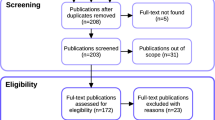Abstract
In this paper, we focus our attention on providing robots with a system that allows them to automatically detect behavior patterns in other robots, as a first step to introducing social responsive robots. The system is called ANPAC (Automatic Neural-based Pattern Classification). Its main feature is that ANPAC automatically adjusts the optimal processing window size and obtains the appropriate features through a dimensional transformation process that allow for the classification of behavioral patterns of large groups of entities from perception datasets. Here we present the basic elements and operation of ANPAC, and illustrate its applicability through the detection of behavior patterns in the motion of flocks.
Access this chapter
Tax calculation will be finalised at checkout
Purchases are for personal use only
Preview
Unable to display preview. Download preview PDF.
Similar content being viewed by others
References
Sam Ge, S., Mataric, M.: Preface. International Journal of Social Robotics 1, 1–2 (2009)
Duffy, B.R.: Fundamental Issues in Affective Intelligent Social Machines. The Open Artificial Intelligence Journal 2, 21–34 (2008)
Bekey, G.A.: Autonomous Robots, From Biological Inspiration to Implementation and Control. The MIT Press, Cambridge (2005)
Arcady Meyer, J., Husbands, P., Harvey, I.: Evolutionary robotics: A survey of applications and problems. In: Husbands, P. (ed.) EvoROB/EvoRobot 1998. LNCS, vol. 1468, pp. 1–21. Springer, Heidelberg (1998)
Breazeal, C.L.: Designing Sociable Robots. MIT Press, Cambridge (2002)
Asada, M., Hosoda, K., Kuniyoshi, Y., Ishiguro, H., Inui, T., Yoshikawa, Y., Ogino, M., Yoshida, C.: Cognitive Developmental Robotics: A Survey. IEEE Transactions on Autonomous Mental Development 1(1), 12–34 (2009)
Kuniyoshi, Y.: Fusing autonomy and sociability in robots. In: Proceedings of the First International Conference on Autonomous Agents, pp. 470–471 (1997)
Kuniyoshi, Y.: Behavior Matching by Observation for Multi-Robot Cooperation. In: Proceedings of the Seventh International Symp. on Robotics Research, pp. 343–352 (1996)
Isler, V., Spletzer, J., Khanna, S., Taylor, C.: Target tracking with distributed sensors: the focus of attention problem. In: Proceedings IROS 2003 (2003)
Parker, L.: Distributed algorithms for multi-robot observation of multiple moving targets. Autonomous Robots 12(3), 231–255 (2002)
Bruce, J., Balch, T., Veloso, M.: Fast and inexpensive color vision for interactive robots. In: Proceedings IROS 2000 (2000)
Roduit, P., Martinoli, A., Jacques, J.: Quantitative Method for Comparing Trajectories of Mobile Robots Using Point Distribution Models. In: Proc. of the 2007 IEEE/RSJ Int. Conf. on Intelligent Robots and Systems (IROS 2007), pp. 2441–2448 (2007)
Stroupea, A., Balch, T.: Value-based action selection for observation with robot teams using probabilistic techniques. Robotics and Autonomous Systems 50, 85–97 (2005)
Reynolds, C.: Flocks, herds and schools: A distributed behavioral model. In: SIGGRAPH 1987: Proc.14th Annual Conf. on Computer Graphics and Interactive Techniques, pp. 25–34 (1987)
Author information
Authors and Affiliations
Editor information
Editors and Affiliations
Rights and permissions
Copyright information
© 2010 Springer-Verlag Berlin Heidelberg
About this paper
Cite this paper
Prieto, A., Bellas, F., Caamaño, P., Duro, R.J. (2010). Automatic Behavior Pattern Classification for Social Robots. In: Graña Romay, M., Corchado, E., Garcia Sebastian, M.T. (eds) Hybrid Artificial Intelligence Systems. HAIS 2010. Lecture Notes in Computer Science(), vol 6076. Springer, Berlin, Heidelberg. https://doi.org/10.1007/978-3-642-13769-3_11
Download citation
DOI: https://doi.org/10.1007/978-3-642-13769-3_11
Publisher Name: Springer, Berlin, Heidelberg
Print ISBN: 978-3-642-13768-6
Online ISBN: 978-3-642-13769-3
eBook Packages: Computer ScienceComputer Science (R0)




